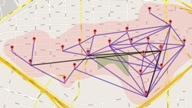Rice University melding WiFi with DTV white space spectrum

Rice University researchers have won a $1.8 million federal grant for one of the nation’s first, real-world tests of wireless communications technology that uses a broad spectral range — including dormant broadcast television channels called white space — to deliver free, high-speed broadband Internet service.
The five-year project calls for Rice and Houston nonprofit Technology for All (TFA) to add white space technology to the wide spectrum WiFi network they jointly operate in Houston’s working-class East End neighborhood.
The TFA wireless network, launched in 2004 with a grant from the National Science Foundation (NSF), now uses unlicensed frequencies ranging from 900MHz to 5GHz.
The new grant, also from the NSF, will allow researchers to take advantage of new federal rules that allow the use of licensed TV spectrum between 500MHz to 700MHz. The network will dynamically adapt its frequency usage to meet the coverage, capacity and energy-efficiency demands of both the network and clients.
The grant will also pay for the development and testing of custom-built networking gear as well as smart phones, laptops and other devices that can receive white-space signals and seamlessly switch frequencies. It will allow Rice social scientists to conduct extensive studies in the neighborhood to find out how people interact with and use the new technology.
“Ideally, users shouldn’t have to be concerned with which part of the spectrum they’re using at a given time,” said Rice’s Edward Knightly, principal investigator on the project. “However, the use of white space should eliminate many of the problems related to WiFi dead zones, so the overall user experience should improve.”
White space is unused frequencies that are set aside for television broadcasters. It includes TV channels that are unused in a particular market, as well as the spaces between channels that have traditionally been set aside to avoid interference.
Get the TV Tech Newsletter
The professional video industry's #1 source for news, trends and product and tech information. Sign up below.
White space has become a hot-button issue in recent years, with Congress and the FCC each debating whether to auction or make freely available the broadcast frequencies that were freed up by the 2008 switch from analog to digital TV broadcasting.
Knightly said that one payoff of the five-year NSF grant will be that all the information about the Rice/TFA tests — how the equipment works, how much it costs to operate, how citizens use it, etc. — will be freely available.
That should make it easier for companies and municipalities to assess the cost of setting up and operating their wide-spectrum network, and it may also help regulators as they compare the pros and cons of auctioning off white-space bandwidth or freeing it for unlicensed, WiFi-style development.
